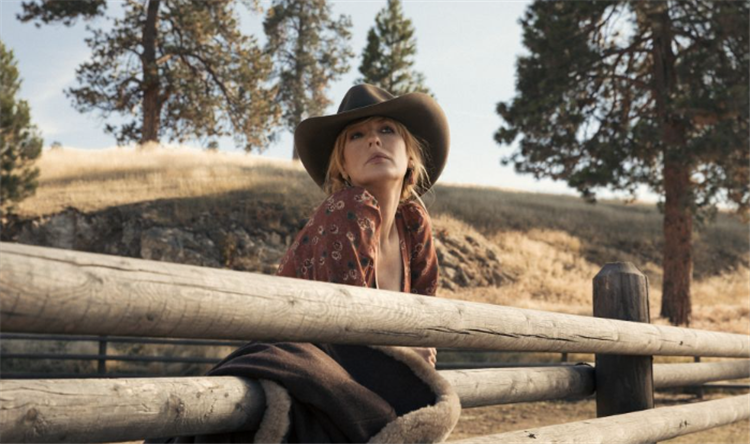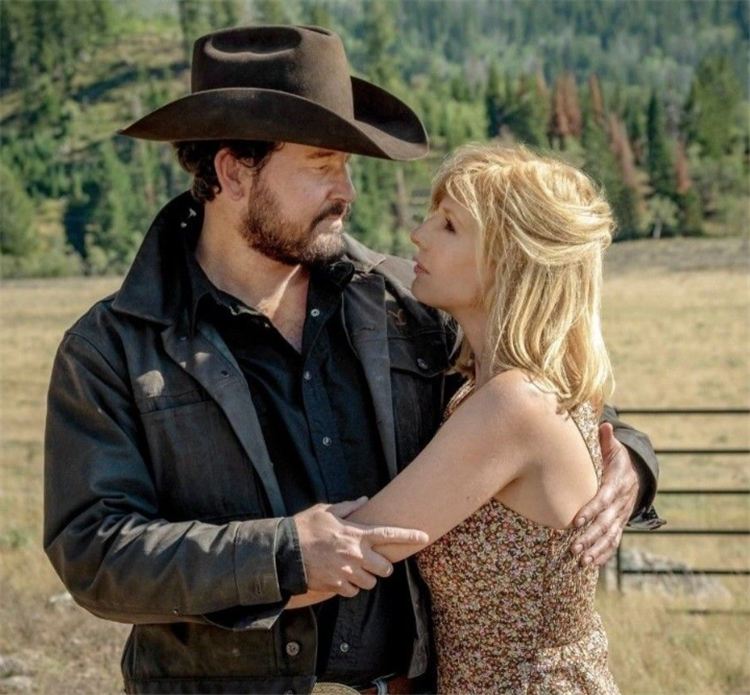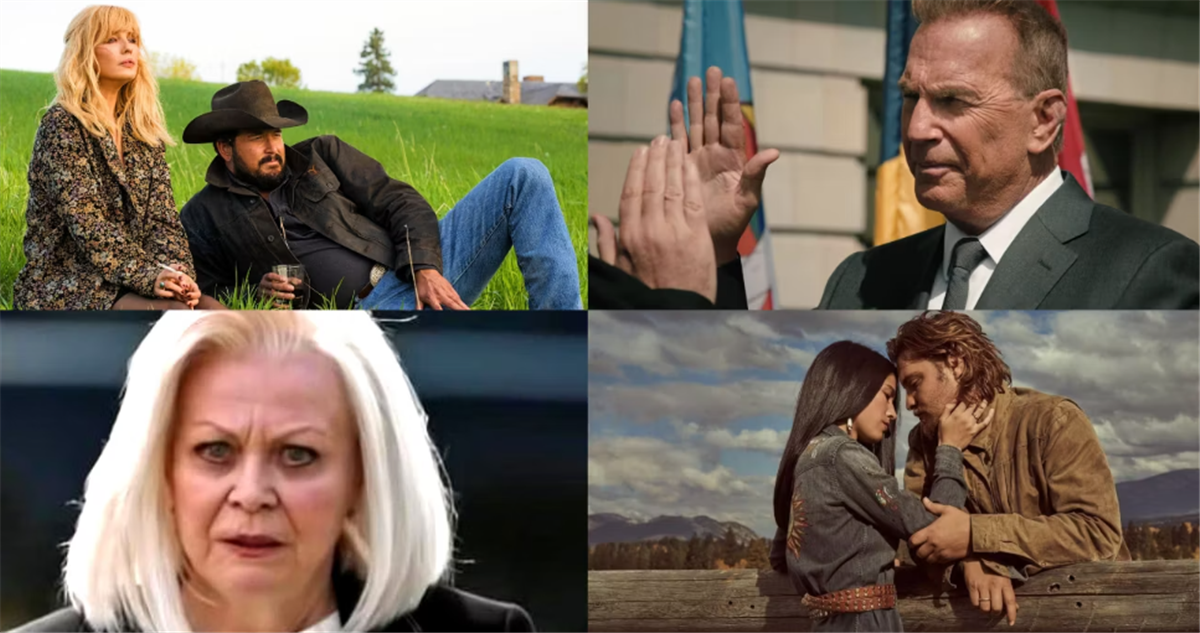Many cowboy songs also serve as cautionary tales for the women who are left behind. Mothers and wives can relate to their lyrics about “broken bones” and broken homes. They apologise, but they won’t back down. The songs evoke the dusty mythology of the American West, with its apparently barren landscapes, exhilarating possibilities, and tests of manhood, while also acknowledging its price: For the cowboy to enjoy his freedoms, innumerable others must give up theirs.
Yellowstone, Taylor Sheridan’s TV juggernaut, is a new version of those old anthems. It is a show about a ranch that sprawls across southern Montana—the Yellowstone, owned for generations by the Dutton family—and the lengths the family will go to in their fight to keep the land for themselves. Yellowstone is also, as its central female character proves, a show about men: cowboys both literal and aspirational. Beth is the only daughter of the land baron John Dutton (Kevin Costner), and she is one of the three surviving children struggling with the inheritance John will—or will not—leave them. Played by the English actor Kelly Reilly, Beth is that too-rare figure in the world of prestige TV: an antihero who is also a woman. She is an agent of chaos. She is mercurial. She is cunning. She is funny. She is wise. She is cruel. Her father loves her dearly; he remarks, offhandedly, that she is “evil.”
Beth takes the stereotype of the femme fatale and knocks it askew: Although the term suggests a woman who will kill, Beth is a woman who will hold the knife to your neck and, rather than making the slice, delight in reminding you how easily she could. She is not simply a woman in a man’s world, although that is certainly the fact of her situation; she is also a woman who acts like a man in a man’s world. Almost every trait of Beth’s—her swagger, her savagery, her insecurity—stems from that dissonance. One mark of a compelling story is that its tropes are beginnings rather than endings. Yellowstone bears that brand. Much of the discussion surrounding it concerns its reputed status as a “red-state show.” But Yellowstone refuses, at every turn, to reduce itself to an easy cultural artifact. Its joys lie in its contradictions. The same is true of Beth, who is at once Yellowstone’s best character and its worst person. “Love you,” she tells her father, kissing his head lightly as she prepares to leave for work one morning. “Off to ruin a life.”
Beth will justify the day’s brutal business the same way she justifies almost everything she does: It is all, she will say, for family. Family, for the Duttons, is a form of manifest destiny; it is a moral code that often works to justify immorality. The Duttons murder and maim and torture. They ignore the rules, and make them. (In the fifth season of the show, which premiered this week on Paramount Network, John becomes, quite literally, a lawmaker.) In war, the standards are different. So the Duttons summon its language—“enemies,” “battles,” “our side”—as convenient incantations. Winning, whatever the cost, is necessary if John is to keep the promise he made to his father—the one his father made before that, and so on for generations: Keep the land. Never sell. Never cede an inch. One of Yellowstone’s many ironies is that it is, at its core, a show about real estate.

Beth, being a woman, is excluded from the Duttons’ physical fights. She wages hers, instead, through acts of psychological warfare. The first time we meet her, she is in a sleek boardroom, orchestrating a hostile takeover of an oil company. Its founder begs her for mercy: He started the whole thing in his garage, he says, and has given his life to it. She refuses. “Bitch,” he mutters.
Epithets, for Beth, are badges of honor: They mean that she has won whatever battle she has chosen to wage that day. She has conquered more territory, planted more flags. Many of Yellowstone’s tensions stem from characters being caught between different worlds. Monica, Beth’s sister-in-law, is by blood and upbringing a member of the Confederated Tribes of Broken Rock; her ancestors lived on the land that is now the Yellowstone. She is also, by her marriage to Kayce, a Dutton. Kayce is a military officer by training (he fought in Afghanistan) and a cowboy by nature; Jamie, his brother, is a wrangler with a law degree; John is a land baron and therefore a reluctant politician. All of them struggle with belonging—all of them, that is, except Beth. She isn’t anxious about where she stands in a world defined by fences. She makes every place her own. “You are the trailer park,” she tells a rival. “I am the tornado.”
Beth drives a Mercedes and bulk-orders from Gucci and is an expert in mergers and acquisitions. But she is also at home on the land. In Yellowstone’s world, oneness with nature is a measure of not moral goodness, but a more pragmatic brand of merit. (Rip, the ranch’s fixer, is an unrepentant murderer and a grizzled avatar of what some call “natural law.”) Beth embodies that. She wears nature, often, quite literally—one of her go-to accessories is fur. When she has something to prove, which is most of the time, she dons animal prints. Whatever the context, whatever the time of day, Beth’s pale-blue eyes will likely be ringed with thick circles of kohl.
These are not merely aesthetic choices—they are indications of character. Beth is feral, but more specifically, she is feline: She plans and waits and stalks. Many cats of prey have eyes that are similarly circled—an adaptation, honed over wild millennia, that helps sharpen their vision for the hunt. And Beth is, perhaps above all, a hunter—of men and money and vengeance. Rip, at one point, invites her to a music festival. She refuses, telling him to pick something better suited to her personality. When he proposes that they get drunk and watch wolves eat a carcass, her eyes light up: She is not used to being so thoroughly understood. Beth believes in Darwinism in its various forms: its sense of genetic determinism; its assertion that might makes right; its stark understanding that death, fundamentally, makes life what it is. “Killing’s the one thing that everything on this planet does to survive, Tate,” John tells his young grandson after he teaches the boy how to kill a buck. “It’s the one thing we all share.”
Beth is the exception who proves the rule. She does not hunt with the men; that is not a woman’s place in this world. But her bloodlust is as strong as theirs; she has merely found other outlets for it, and other victims. Again and again, characters who do not share Beth’s most defining conviction—that there are insiders and outsiders, and that everything flows from this distinction—meet downfalls of epic proportions. “I believe in loving with your whole soul and destroying anything that wants to kill what you love,” she tells Rip. “That’s it. That’s all there is.”

Were Yellowstone a simpler show, it might stop there: Beth the romantic, Beth the chaotic, Beth the Manichaean. But her approach to the world, like everything else on the Dutton ranch, has outside competition. “Family” is not a straightforward matter, and every character has a wildly different idea of what belonging really entails—even as they summon it as a rationalization for their excesses. One of John’s opponents is Thomas Rainwater, the leader of the Confederated Tribes of Broken Rock and a foe as savvy and ruthless as the Duttons; for Thomas, “family” is the confederation, and the broader group of Americans who have borne the brunt of institutional injustice. The dissonance between their definitions—family as expansive and communal; family as stiflingly small—feeds some of Yellowstone’s most resonant interests: What is family, really? Is it a genetic fact or an ongoing act—of love, of labor, of endurance? How far do its protections extend? What do its exclusions mean for those on the wrong side of the fence?
For a show with a fairly narrow universe of main characters, Yellowstone features a remarkable number of adoption stories. Several main characters either adopt children or discover that they themselves were adopted. Beth, who cannot have children physically, takes in a young teenager whose parents have died. Later, when he calls her “mama,” she chides him: “I’m not your mother,” she growls, and she means it. Beth may be a woman who parents a kid, but she is stridently anti-maternal. Early in Yellowstone, Beth ends up an extremely reluctant babysitter for Tate, the nephew she barely knows. He’s hungry and asks her what she can cook. “A cheese plate,” she replies.
The traumatized, without intervention, can become trapped in the moment of their injury. They can age without maturing. Beth’s mother died in front of her when Beth was a teenager—and maybe, Beth thinks, because of her. Beth is, in that way, the inverse of a superhero: The pain of the lost parent, rather than honing her sense of justice, obliterates it. In the show’s telling, her mother’s sudden death—an accident, split-second and endless—is the moment that Beth the person ended and Beth the monster began. Her grief traps her in a state of perpetual youth, making her both theatrically womanly and temperamentally adolescent, moody and melodramatic. She is in her 30s and calls her father “Daddy.” She does so unironically.
Beth is not merely tender toward her father; she treats him with the kind of fervent devotion that usually flows from parent to child. Beth is so completely maternal toward John that she oversees his diet (the fruit in the salad she serves him is good for prostate health, she explains to a full dinner table). She monitors his sex life. She is recklessly committed to preserving the ranch not for the land’s sake or for her own—she can’t wait for the day she’s rid of it, she says—but for John’s. In Beth, the typical timeline is reversed: The child holds the life of the parent in her hands.

The disorder is apt. The Dutton ranch is a place where people are branded along with the cattle, where grizzlies are roped like steer, where the physics that constrain the rest of the world no longer apply. The ranch’s spindly fences are misleading: The Yellowstone, for Beth as for so many others, is a paradise with no escape. Beth, though she has lived in the world beyond Montana—and though she is a skilled performer of disaffected urbanity—never really left home. She never got to figure out who she might be beyond, as so many characters call her, “the farmer’s daughter.” Instead, the ranch’s chronic chaos has resolved itself in her. In Beth, qualities that are stereotypically feminine—her sensitivity, her selflessness—curdle. Her intuition is her weapon; her devotion to her family is her absolution, she assumes, for all she destroys in the war.
In Beth, too, the rugged individualism so deeply associated with the American West transforms into something else: rugged exceptionalism. Her family values are her only values. And they tell her that other families must lose so that hers can win. Were the Duttons straightforward protagonists, it would be easy to read the show as endorsing the anti-communal and winner-take-all attitudes that have become so common in American politics. But the Duttons are not the only characters on Yellowstone, and their assumptions are not its only values. “I’m like, ‘Really?’” Sheridan told Sridhar Pappu, of the chatter surrounding the series. “The show’s talking about the displacement of Native Americans and the way Native American women were treated and about corporate greed and the gentrification of the West, and land-grabbing. That’s a red-state show?” Ultimately, Yellowstone’s scripted melodramas resolve not with exclamations, but with question marks and ellipses. The Duttons have their codes, but it does not follow that the codes are correct. The cowboys are not always the heroes.
Beth personifies that conflict. She is a dreadful person outside of the ranch. She is, nonetheless, the most moral member of the Dutton family. She reprimands her siblings for not being devoted enough to their father, his father, and the property. She is fully committed to the cause, whereas they are only somewhat so. Her legacy is one of giving. In one battle for the family, Beth suffers a nasty gash on her cheek, just next to her eye. While the wound recovers, the scar does not. From a distance, it appears to be tearing.
